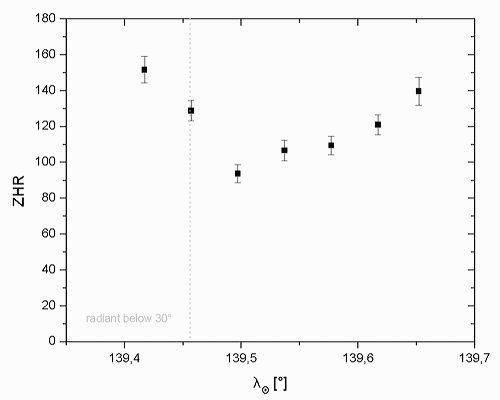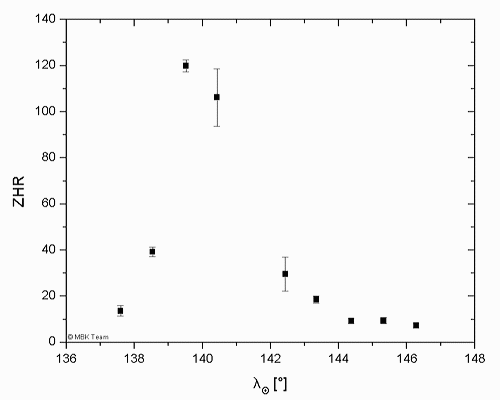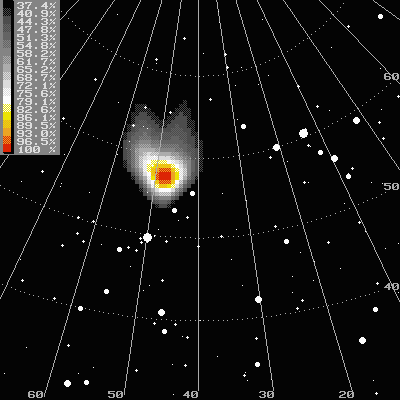Perseids 2004
Most of the MBK Team's 2004 Perseid observations were done at the Youth astronomical research camp 2004 (YARC 2004) that took place from August 10 to 19 at Trije Kralji on Pohorje Mountain, Slovenia.
OBSERVATIONS
Several observational methods were used. Nine observers covered meteor activity with visual observations.
Photographic, including all-sky, and video observations were also employed.
Nine observers covered nine nights with the observations around the maximum of the Perseids.
In 113.3 hours of observations 4478 meteors were recorded with 3234 of them being Perseids (see Table below). Other showers were also seen: 45 Alpha Capricornids, 82 Kappa Cygnids, 11 Northern Delta Aquarids, 9 Northern Iota Aquarids, and 170 unresolved Aquarids.
Table: Visual observer's statistics for the 2004 Perseids.
| Observer | IMO code | Teff [h] | Total | Spor | PER | Other |
| Javor Kac | KACJA | 30.82 | 1029 | 244 | 705 | 80 |
| Mitja Govedic | GOVMI | 27.75 | 743 | 179 | 467 | 97 |
| Jaka Dobaj | DOBJA | 22.89 | 862 | 209 | 596 | 57 |
| Jure Atanackov | ATAJU | 10.33 | 847 | 137 | 682 | 28 |
| Janez Kos | KOSJN | 6.46 | 348 | 39 | 277 | 32 |
| Marusa Kuk | KUKMA | 5.96 | 205 | 48 | 157 | |
| Gregor Kladnik | KLAGR | 4.49 | 257 | 34 | 200 | 23 |
| Dunja Fabjan | FABDU | 2.50 | 52 | 20 | 32 | |
| Aleksandra Brglez | BRGAL | 2.11 | 135 | 17 | 118 | |
| totals | 113.31 | 4478 | 927 | 3234 | 317 |
ANALYSIS
Population index of the Perseids
The population index r was calculated for six one-hour intervals in the night 2004 August 11/12
(Figure 1). A higher value of r = 2.20 +/- 0.09 can be seen early in the evening. A minimum of r = 1.87 +/- 0.08 was
reached at about 22h30m UT. After that the population index slowly rises again to reach r = 2.14 +/- 0.07 in the last hour before dawn.

Figure 1: Population index profile on the maximum night, calculated from MBK Team observations.
Activity profile of the 2004 Perseids
Activity for the maximum night was calculated using population indices shown in Figure 1. The detailed Perseid activity profile is shown in Figure 2. The activity was highest at the beginning of the night with a maximum value of ZHR = 152 +/- 7 at 20h15m UT. The average radiant height during this period was only 24°. The Perseid activity then declines to a local minimum of ZHR = 94 +/- 5 at 22h15m UT. This coincides with a minimum of the population index. We checked if a maximum of the population index defines the local minimum in ZHR. We found that if the population index of 2.1 was used throughout the night the shape of the profile was not changed much.
After the local minimum the ZHR slowly rises to reach 140 +/- 8 in the last period before dawn.

Figure 2: Details of the ZHR profile on the maximum night, calculated from MBK Team observations using population index from Figure 1.
The activity profile for the whole observation period is shown in Figure 3. The Perseid ZHR was only 14 +/- 2 on August 9/10. Next night it rose to 39 +/- 2 Perseids per hour. The average ZHR on the maximum night was 120 +/- 3. The night of August 12/13 was only partially clear early in the evening so only a couple of hours of observations were possible. The calculated ZHR for this evening was 106 +/- 13 with a radiant at only 30° above horizon. The following nights of the YARC 2004 saw a gradual decline in Perseid activity from 30 +/- 7 on August 14/15 to 7 +/- 1 on August 18/19.

Figure 3: ZHR profile of the 2004 Perseids from MBK Team observations. Population index used was r=2.1 except for the maximum night when population index from Figure 1 was used. Only two observers observed around l¤=140.5° and only one around l¤=142.5°, therefore large error bars.
Photographic observation results
A number of bright Perseids and other meteors were caught on photos. The highlight of the Camp was a fireball of at least -6th magnitude that was recorded on August 16, 2004 at 22h12m30s UT
and was also caught on our all-sky camera.

Figure 4: A -7th magnitude meteor in Pisces/Cetus was caught by MBK Team's all-sky camera on August 16, 2004
at 22h12m30s UT. Exposure from 22h11m48s to
22h21m36s UT. Photo by Javor Kac.
Radiant positions
Radiant position for the maximum night (shifted to l¤ = 140.0°) was calculated using 148 meteors and is located at a = 48.2° and d = 57.9°. This is in good agreement with the data given by the IMO that gives the expected radiant position at a = 46° and d = 59°.

Figure 5: Perseid radiant position for August 11/12, 2004.
| 





